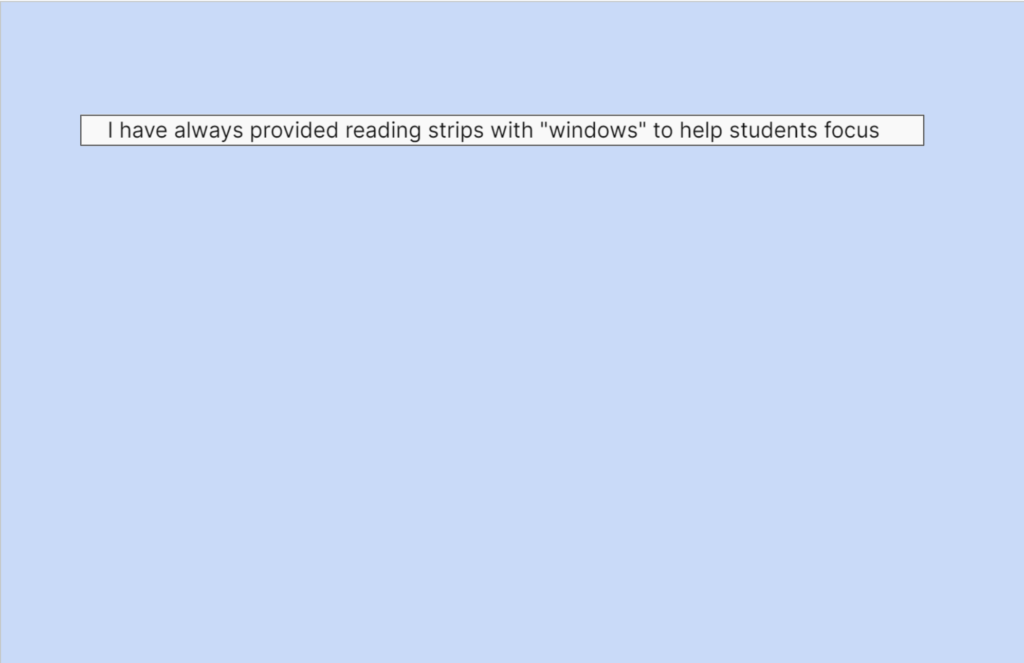I was a third grade teacher for 28 years. Every year I worked with struggling readers. Recently I decided to retire and I am now a tutor. Today I was reading with third, fourth, and fifth graders. The students were struggling to find text evidence to support their answers. Several of them could tell me what the answer was, but couldn’t find the words in the text. I asked them why it was difficult for them. They told me that there were so many words to look at, it was hard to find what they were looking for. As I listened to students read, they were:
- skipping small words (on, the, etc..)
- losing their place while reading
- reading small words incorrectly (for, the, they)
- struggling to move from one line to the next
- struggling to keep up with where we were reading
I have always encouraged students that were struggling to use a reading tracker to help keep them focused on a smaller section. I have also suggested for those students that struggle with comprehension to read aloud to themselves. After I got home, I started searching to see if I could find any new strategies. Tonight, I realized there is a good reason behind utilizing these two strategies. Read on to find out what I learned!
What I Learned about Struggling Readers
I was surprised how many optometrist’s websites popped up in my search. According to these and other sites, a struggling reader might have difficulty with eye tracking. Eye tracking is the student’s ability to move from left to right and from one line to the next efficiently. When a student’s eye muscles do not track together easily, it makes reading more difficult and uncomfortable. Tracking is a very important skill to be successful at reading. Students should be able to move their eyes smoothly across the page, and not jump around. If you notice a student doing any of these things, they may have an eye tracking problem.
- lose their place
- skip over words or lines
- adds word that are not there
- reading words in a different order that are printed on the page
- avoids books that have small print
- can read single words, but struggles when reading lines of text
- does not read word endings
- struggles to visualize what they are reading
Reading Strips
I have always provided reading strips with “windows” to help students focus on one line at a time. Some students prefer a narrow strip that blocks just the line above and below. Other students prefer to use a strip that blocks more of the text (several paragraphs). What I didn’t know was that when used continuously, this can improve a student’s hand-eye coordination. As a result, it will improve fluency and comprehension.

Reading Aloud
Another suggestion I make to students is to read out loud. I can read an entire page of a book and not know what it was about when I am reading in my head. If I read it out loud, my comprehension is much better! What I did not know was that this forces your eyes and brain to work together. The student’s concentration and comprehension both improve.
Students can use whisper phones, or they can plug both their ears and whisper to themselves. Both of these makes their voice sound louder to them, but do not disturb others. Reading aloud does need to be done consistently to get the best results!
Exercises & Activities
Apparently, there are simple exercises that can be done to improve eye tracking. Staring at an object without making eye movement is one. Another is putting your finger out and moving it in circles while tracking your finger and not moving your head. You can read, and watch a video demonstration at helpingchildrentoread.com.
In addition, working on gross motor skills can also strengthen a persons visual tracking ability. Check out this blog on yourtherapysource.com for some gross motor activities. Something as simple as bouncing a ball back and forth with a partner can improve a person’s eye-hand coordination. Take several brain breaks and choose one of these balance and movement activities that can help improve visual skills.
There are also some paper and pencil activities that can help with eye tracking. Puzzles, mazes, dot to dots, tangrams, hidden pictures, tracing, drawing, and painting were all suggested. They all work on hand-eye coordination, and strengthen visual skills. Why not include these as an option during indoor recess, or as morning work?
Therapy
I am unsure how easy it is to find an optometrist that tests for a visual tracking difficulty and offers vision therapy. There certainly were a lot of optometrist’s websites that had information on this topic. A child should be evaluated by an eye specialist to determine if a child truly has difficulty with eye tracking.
It is important to note that not all students that have these reading difficulties have an eye tracking deficit.
Want to learn more?
These are the websites I found most helpful:
- theottoolbox.com – visual tracking activities/toys
- goodsensorylearning.com – ways to strengthen visual tracking
- see-and-read.com
- helpingchildrentoread.com
- bonnieterrylearning.com
- eyetrends.com
- woodlandsvt.com

